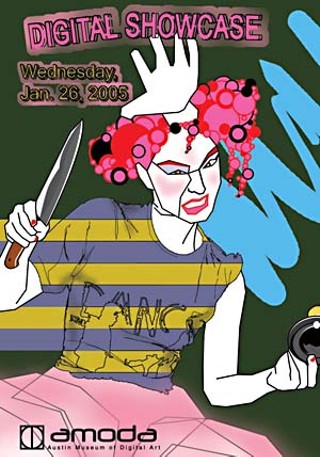AMODA's Operandi
Just what, exactly, is the Austin Museum of Digital Art up to these days?
By Wayne Alan Brenner, Fri., Sept. 18, 2009
These are the days of miracles and wonders, when some punk with a $1,000 piece of plastic and silicon can command powers previously available only to large media studios with budgets like the gross domestic product of a small country. These are times when last century's video games are deconstructed and reconfigured to create psychedelic visions never intended by the original producers, when sound waves are regularly bent, shifted, and layered independent of analog instruments – not as bold experiments, necessarily, but as a matter of pop music rigmarole.
This is now: when Third World cultural memes virus swiftly through the Internetted strata of moneyed nations and metastasize among the meatspace populace. When video manipulation blurs the division of real and unreal and collapses recorded history to an anachronistic clusterfuck. When much of what William "Neuromancer" Gibson used to write as science fiction begins to seem like yesterday's news.
These are digital days, and they're thick with artists – artists who push the technological boundaries of expression further with every bend of a circuit, every twitch of a knob, every densely packed recontextualization of what's come before. The improvised video projections of Dan Winckler; the sonic extrapolations of Kevin Blechdom's big, weird heart; the crowd-responsive graphic environments of software engineer Zack Booth Simpson; the game-soundtrack mixology of Ariel Quintans, aka DJ Fuckin' A: This is not some graying curator's business as usual. This is not the sort of art, of creative industry, that's regularly encompassed by a city's more old-school contingent of galleries and exhibitions. You want to bust these ghosts out of the machine, so to speak? Who you gonna call?
AMODA.
Break it down: A-M-O-D-A.
Austin, Museum, of, Digital, Art.
AMODA defines digital art as "art that uses digital technology in any of three ways: as the product, as the process, or as the subject."
"As the product" is like when someone expresses himself/herself by building a website, say, or something robotic. "As the process" would be like someone writing a play based on a Facebook chat log or composing an entire symphony from downloaded ringtones. "As the subject" could be an old masters-style painting in oils, fully analog ... but, instead of Vermeer's milkmaid or Frans Hals' cavalier, it's the image of a brand-new hard drive; it's a portrait of Aimee Weber.
What defines an organization is, of course, what that organization does and the people who are involved in doing it. AMODA Executive Director Todd Simmons – who has worked as a sound designer and audio engineer at Austin video-game companies Human Code, Ion Storm, and Retro Studios – is one of those people, if not from the beginning.
"I wasn't around when AMODA first started," says Simmons. "It was started in '97 by Harold Chaput and Rob Turknett and a few others. For the first years, they were getting the nonprofit paperwork set up, figuring out how to get things off the ground. They had a series of small parties that they were using as fundraisers to establishing a physical space for AMODA, and I was at one of those parties back in, like, 2000, 2001. And, after the party, I told them that they could have done it better by making it more about high-quality digital art and music instead of just throwing a party for the sake of fundraising. And they kind of challenged me. You know: 'If you're so smart, why don't you go and do that?' So that was how I came on board."
And immediately established the Digital Showcase Series.

"Well, I tried to resist for a while, but they slowly roped me in, and that led to the start of it. By now we've had around 45 or 46 Digital Showcases in clubs and bars; they're our most frequent events. It's a fun social gathering, but we feature musicians from Austin and out of town and visual artists from around the world. We find artists online, people who are doing out-there and quirky kind of stuff, and contact them and have their work sent to us over the Internet or through the mail. And we use it to assemble a show that's as visually and musically interesting as we can make it."
Among the artists, both visual and musical, whose works have been experienced at these showcases: the above mentioned Winckler, Blechdom, Simpson, and Quintans, as well as Feedtank, Ben Aqua, Hana Hillerova, Xiu Xiu, Paper Rad, Golan Levin, William Hundley .... Oh, the list goes on and on. All the myriad marvels, serving to creatively spice the alcohol-fueled, beat-driven nightlife. But does that mean AMODA is just some enhanced club scene with delusions of neo-Warhol?
"Well, at this point we haven't had as many opportunities for actual gallery-based events," allows Simmons. "That's another side of AMODA, but we've only had three or four of that sort of exhibition throughout our history, and we haven't had one for the last several years. It's something we're really interested in doing more of as soon as possible, because it's core to what the group intended when it started – to show art in a gallery or museum type of setting. But it's a challenge to do that, because AMODA doesn't have a physical space."
These are digital days, but they're also depression days. So it's a money problem?
"We've had different exhibition series directors come and go over the years, too," says Simmons, "so we're still working to find someone to fill in that role."
So it's a people problem? A certain lack in the old HR department? The digital, hamstrung by the analog: Is this a problem of focus? Could AMODA, so good at defining the parameters of what it wishes to encompass, be less capable of defining itself?
Simmons: "We recently finished a strategic planning process, with the board of directors and a few of us who've been around for a while meeting over many months to try and figure out what our direction should be." This, after almost 10 years of successful digital showcases. Is this typical of bricks-and-mortar art concerns, too, or does new media itself, as a few Luddite fearmongers suggest, instill a sort of debilitating attention deficit disorder in those who partake?
"We've always wanted to have a space, a paid staff," says Simmons, "and those are the two main goals, but it takes a lot of organizing effort to pull that off. We have a list of artists we've worked with in the past whose work we've loved and a list of artists whose work we love but we haven't had a chance to show yet – because their work is too elaborate to show in a club setting. You can get into some really high tech equipment and needing to calibrate it fully over the course of a few days with some of the more complex installations. And you just can't do that with a, like, five-hour setup time in some club." And there are always distractions. "We'd love to get more involved with the multitouch technology – like Microsoft's Surface, which is like a giant iPhone screen, essentially. We'd love to get our hands on something like that and feature it at an event, but that sort of device is difficult to get hold of so far. And there's a lot more we'd like to do, like have more interactive pieces where people can affect what's happening on a screen through their actions, whether by moving in front of a camera or dialing in with their cell phone – a lot of different stuff."
So they won't be satisfied with only an endless string of digital showcases in clubs, no matter how enjoyable the party atmosphere may be. The staff at AMODA want to redefine their project toward the original vision: a museum of digital art, after all. There's the problem, while the showcases continue and AMODA presents film screenings (such as Tilt: The Battle to Save Pinball and the Game Developers Conference's Into the Night at the Alamo Drafthouse at the Ritz) and partners with Austin's New Music Co-op to produce its series of experimental audio performances. There's the problem. And the proposed solution?
"We're trying to expand our board of directors and make more contacts in the local philanthropic community," says Simmons. "And, of course, our volunteers. We're always happy to get new people."
We feel that pain. Seriously, it's a basic concern of all arts organizations, and it's either dealt with successfully or eventually it's game over. But we must ask again, like a spam-bot plying the same line of pimpage over and over: Isn't the physical world rather anathema to what Simmons and his posse are all about? The Austin arts group that's avowedly at the forefront of digital aesthetics requires a meatspace showplace? AMODA isn't planning to migrate fully online, into the highly buzzed-about cloud?
The executive director shakes his head. "There are some works of digital art that you can't show only online," he says. "The online component would be a good supplement to it, but there's a lot of digital work that you need to experience in person to get the full effect. In, you know, real life."
And how was Simmons challenged earlier, did he say? Replay sound bite ... now: "You know: 'If you're so smart, why don't you go and do that?'"
END TRANSMISSION.











